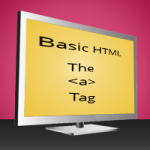For anyone learning how to create a website, you definitely have to learn some of the terminology. I’ve put together 24 common web design terms to help you on you way. 24 Common Web Design Terms HTML – Hypertext Markup Language PHP – Hypertext Preprocessor. This is a server-side scripting language. CSS – This is
[Continue Reading...]html
Basic HTML: The A Tag
The <a> tag is a very common piece of HTML. It allows you to link to other websites or within a website. There are quite a few things you can to with the <a> tag. It is synonymous with the term called hyperlinking. Basic uses of the <a> tag Linking within and to outside sites
[Continue Reading...]Using An Image For The Submit Button
This is a simple tutorial you can use if you would like your submit form to have a submit button other than one you can customize with regular css. I will be using the following image, but you can made your own and adjust the tutorial to what you need it to be to fit
[Continue Reading...]Adding A Favicon To Your Website
The definition for a favicon at Wikipedia is: A favicon (short for favorites icon), also known as a website icon, shortcut icon, url icon, or bookmark icon is a 16×16, 32×32 or 64×64 pixel square icon associated with a particular website or webpage. For the rest of us who are not as technical. It is
[Continue Reading...]Understanding How to Use The W3C Markup Validation Service
Having valid coding for your site is important. It could mean the difference of a visitor being able to access and view your site properly. Whether you are just learning HTML, know a little bit, or know quite a few tricks, one of the best tools a designer and developer can use is the W3
[Continue Reading...]Basic HTML Tutorial – What is HTML?
HTML is a short acronym for HyperText Markup Language. The language consists of tags surrounded by angle brackets and can effect the way a person sees a website. It can be used in scripting languages like cgi, php, and javascript to person any number of actions. Example of a tag: <head>. A basic page consists
[Continue Reading...]


